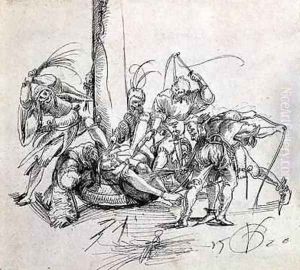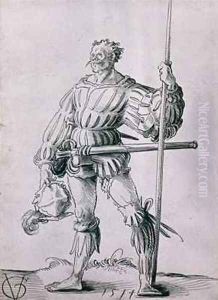Urs (The Elder) Graf Paintings
Urs Graf, often referred to as Urs Graf the Elder to distinguish him from his son of the same name, was a Swiss Renaissance goldsmith, painter, and printmaker. Born in Solothurn, Switzerland, in 1485, Graf was active during a period of significant political and religious change in Europe. He is particularly known for his masterful engravings and woodcuts, which reflect the late Gothic style transitioning into the early Renaissance.
Graf's background as a goldsmith greatly influenced his artistic work, as evidenced by the intricate details and precise lines in his engravings. He served as an apprentice in Basel and later became a citizen of the city. Throughout his life, Graf was involved in various military campaigns and was known for living a tumultuous life, which included periods of imprisonment for unruly behavior. Despite this, he managed to produce a substantial body of work that was both expressive and technically advanced for his time.
His works often contained satirical and sometimes erotic themes, providing a glimpse into the societal and cultural attitudes of the early 16th century. Graf was also notable for his depictions of soldiers and scenes of battle, drawing from his own experiences as a mercenary soldier. These works are valuable not only for their artistic merit but also as historical documentation of military attire and practices of the period.
Urs Graf the Elder's contributions to printmaking have been recognized for their influence on subsequent generations of artists. Despite the challenges and distractions of his personal life, Graf's legacy endures through his surviving prints and drawings. He passed away in 1529, leaving behind a body of work that continues to be studied and admired for its vigor and craftsmanship.

